Summative Report: Distribution of Labour in Amazon Warehouse (UK)
VerifiedAdded on 2020/12/30
|38
|9198
|380
Report
AI Summary
This report provides a comprehensive analysis of labor distribution within Amazon's UK warehouses. It begins with an introduction to the topic, background of the study, and a review of the challenges faced due to unequal labor distribution. The report includes a literature review, examining various theories and strategies related to labor distribution, such as the labor theory of values and the importance of corporate governance. The research methodology, including primary and secondary research, is detailed, followed by a review of the results and recommendations for improvement. The report also includes a research proposal, project title, and a discussion of research ethics. The study highlights issues like performance decline, customer dissatisfaction, and the need for effective strategies to allocate tasks and responsibilities. The findings emphasize the significance of proper labor distribution for enhancing efficiency, productivity, and overall business performance within Amazon.
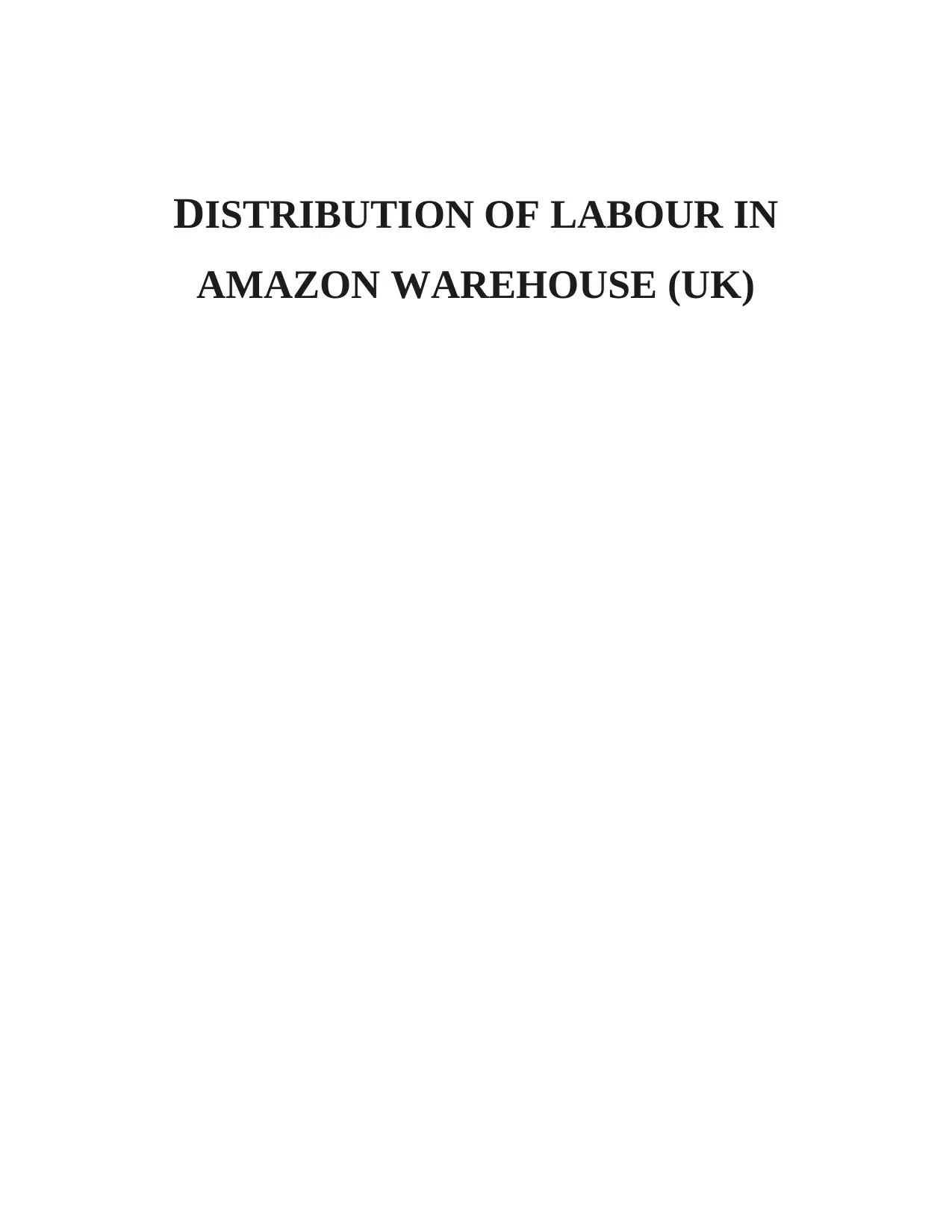
DISTRIBUTION OF LABOUR IN
AMAZON WAREHOUSE (UK)
AMAZON WAREHOUSE (UK)
Paraphrase This Document
Need a fresh take? Get an instant paraphrase of this document with our AI Paraphraser
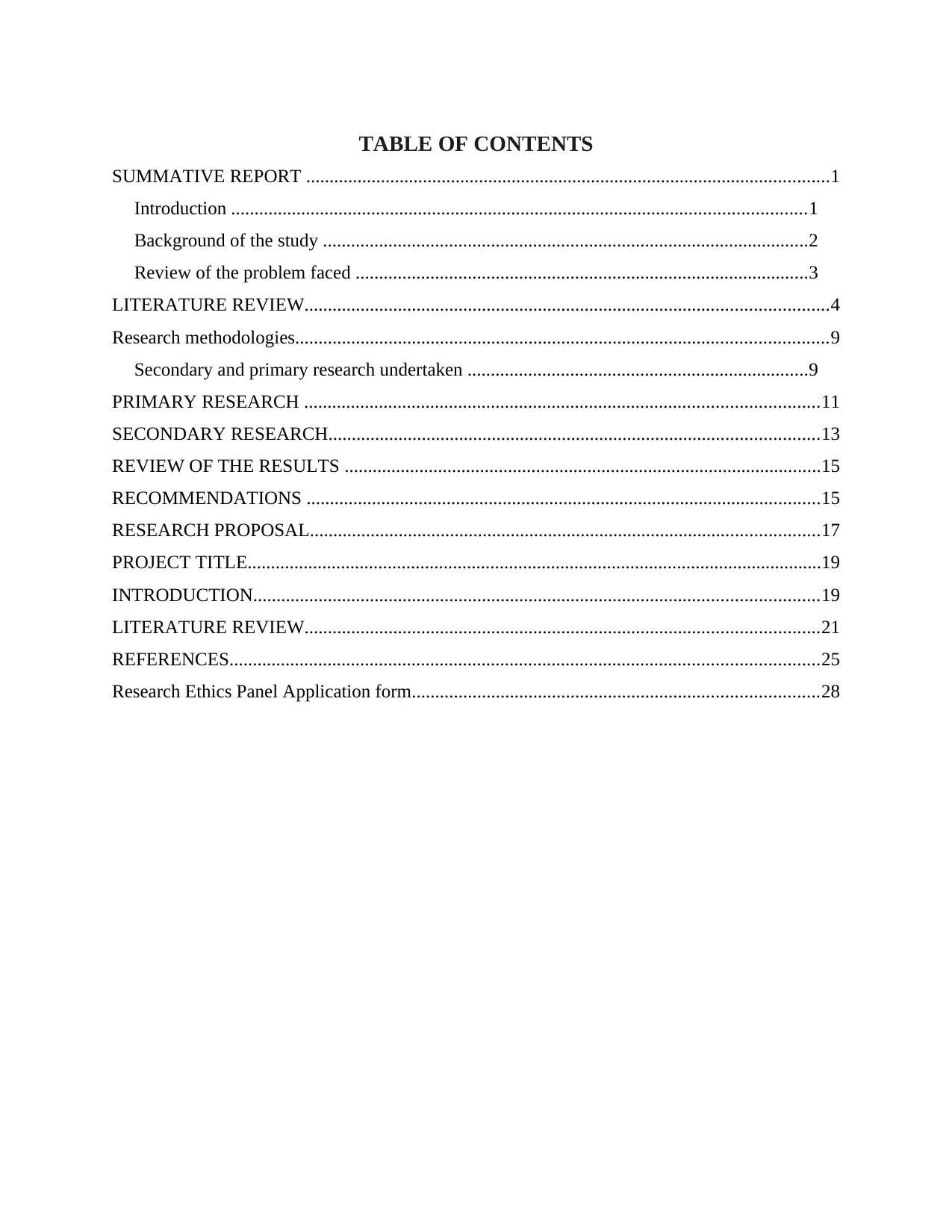
TABLE OF CONTENTS
SUMMATIVE REPORT ................................................................................................................1
Introduction ...........................................................................................................................1
Background of the study ........................................................................................................2
Review of the problem faced .................................................................................................3
LITERATURE REVIEW................................................................................................................4
Research methodologies..................................................................................................................9
Secondary and primary research undertaken .........................................................................9
PRIMARY RESEARCH ..............................................................................................................11
SECONDARY RESEARCH.........................................................................................................13
REVIEW OF THE RESULTS ......................................................................................................15
RECOMMENDATIONS ..............................................................................................................15
RESEARCH PROPOSAL.............................................................................................................17
PROJECT TITLE...........................................................................................................................19
INTRODUCTION.........................................................................................................................19
LITERATURE REVIEW..............................................................................................................21
REFERENCES..............................................................................................................................25
Research Ethics Panel Application form.......................................................................................28
SUMMATIVE REPORT ................................................................................................................1
Introduction ...........................................................................................................................1
Background of the study ........................................................................................................2
Review of the problem faced .................................................................................................3
LITERATURE REVIEW................................................................................................................4
Research methodologies..................................................................................................................9
Secondary and primary research undertaken .........................................................................9
PRIMARY RESEARCH ..............................................................................................................11
SECONDARY RESEARCH.........................................................................................................13
REVIEW OF THE RESULTS ......................................................................................................15
RECOMMENDATIONS ..............................................................................................................15
RESEARCH PROPOSAL.............................................................................................................17
PROJECT TITLE...........................................................................................................................19
INTRODUCTION.........................................................................................................................19
LITERATURE REVIEW..............................................................................................................21
REFERENCES..............................................................................................................................25
Research Ethics Panel Application form.......................................................................................28
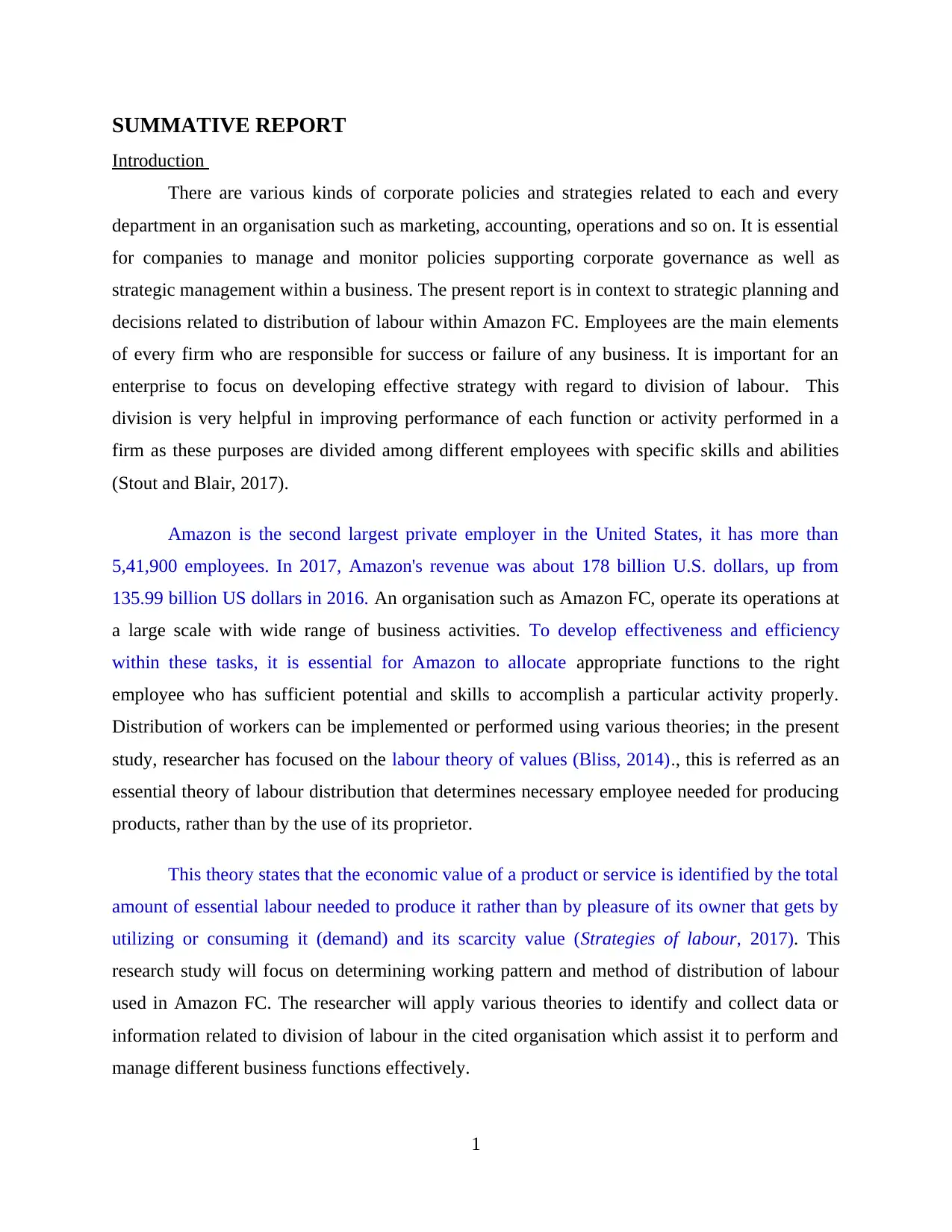
SUMMATIVE REPORT
Introduction
There are various kinds of corporate policies and strategies related to each and every
department in an organisation such as marketing, accounting, operations and so on. It is essential
for companies to manage and monitor policies supporting corporate governance as well as
strategic management within a business. The present report is in context to strategic planning and
decisions related to distribution of labour within Amazon FC. Employees are the main elements
of every firm who are responsible for success or failure of any business. It is important for an
enterprise to focus on developing effective strategy with regard to division of labour. This
division is very helpful in improving performance of each function or activity performed in a
firm as these purposes are divided among different employees with specific skills and abilities
(Stout and Blair, 2017).
Amazon is the second largest private employer in the United States, it has more than
5,41,900 employees. In 2017, Amazon's revenue was about 178 billion U.S. dollars, up from
135.99 billion US dollars in 2016. An organisation such as Amazon FC, operate its operations at
a large scale with wide range of business activities. To develop effectiveness and efficiency
within these tasks, it is essential for Amazon to allocate appropriate functions to the right
employee who has sufficient potential and skills to accomplish a particular activity properly.
Distribution of workers can be implemented or performed using various theories; in the present
study, researcher has focused on the labour theory of values (Bliss, 2014)., this is referred as an
essential theory of labour distribution that determines necessary employee needed for producing
products, rather than by the use of its proprietor.
This theory states that the economic value of a product or service is identified by the total
amount of essential labour needed to produce it rather than by pleasure of its owner that gets by
utilizing or consuming it (demand) and its scarcity value (Strategies of labour, 2017). This
research study will focus on determining working pattern and method of distribution of labour
used in Amazon FC. The researcher will apply various theories to identify and collect data or
information related to division of labour in the cited organisation which assist it to perform and
manage different business functions effectively.
1
Introduction
There are various kinds of corporate policies and strategies related to each and every
department in an organisation such as marketing, accounting, operations and so on. It is essential
for companies to manage and monitor policies supporting corporate governance as well as
strategic management within a business. The present report is in context to strategic planning and
decisions related to distribution of labour within Amazon FC. Employees are the main elements
of every firm who are responsible for success or failure of any business. It is important for an
enterprise to focus on developing effective strategy with regard to division of labour. This
division is very helpful in improving performance of each function or activity performed in a
firm as these purposes are divided among different employees with specific skills and abilities
(Stout and Blair, 2017).
Amazon is the second largest private employer in the United States, it has more than
5,41,900 employees. In 2017, Amazon's revenue was about 178 billion U.S. dollars, up from
135.99 billion US dollars in 2016. An organisation such as Amazon FC, operate its operations at
a large scale with wide range of business activities. To develop effectiveness and efficiency
within these tasks, it is essential for Amazon to allocate appropriate functions to the right
employee who has sufficient potential and skills to accomplish a particular activity properly.
Distribution of workers can be implemented or performed using various theories; in the present
study, researcher has focused on the labour theory of values (Bliss, 2014)., this is referred as an
essential theory of labour distribution that determines necessary employee needed for producing
products, rather than by the use of its proprietor.
This theory states that the economic value of a product or service is identified by the total
amount of essential labour needed to produce it rather than by pleasure of its owner that gets by
utilizing or consuming it (demand) and its scarcity value (Strategies of labour, 2017). This
research study will focus on determining working pattern and method of distribution of labour
used in Amazon FC. The researcher will apply various theories to identify and collect data or
information related to division of labour in the cited organisation which assist it to perform and
manage different business functions effectively.
1
⊘ This is a preview!⊘
Do you want full access?
Subscribe today to unlock all pages.

Trusted by 1+ million students worldwide
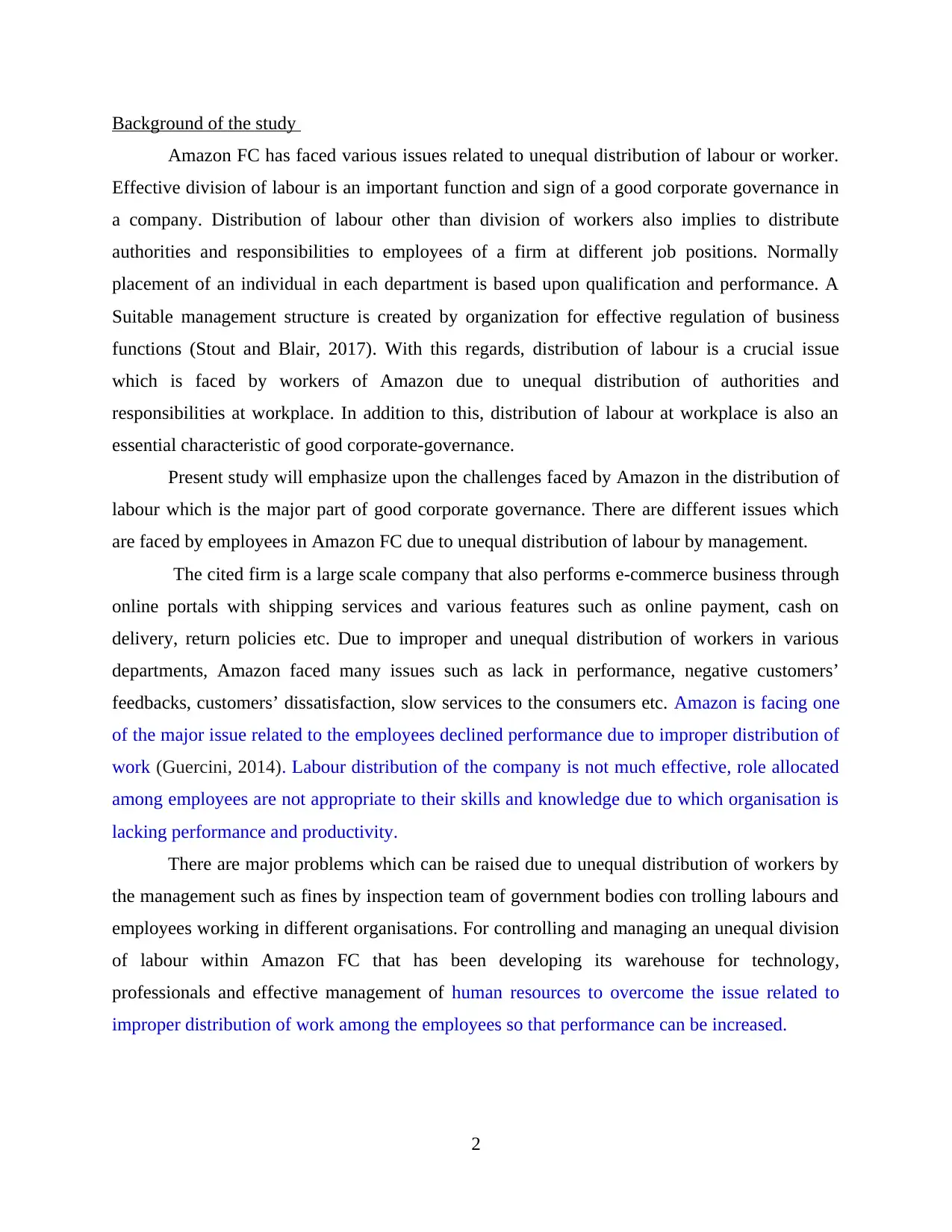
Background of the study
Amazon FC has faced various issues related to unequal distribution of labour or worker.
Effective division of labour is an important function and sign of a good corporate governance in
a company. Distribution of labour other than division of workers also implies to distribute
authorities and responsibilities to employees of a firm at different job positions. Normally
placement of an individual in each department is based upon qualification and performance. A
Suitable management structure is created by organization for effective regulation of business
functions (Stout and Blair, 2017). With this regards, distribution of labour is a crucial issue
which is faced by workers of Amazon due to unequal distribution of authorities and
responsibilities at workplace. In addition to this, distribution of labour at workplace is also an
essential characteristic of good corporate-governance.
Present study will emphasize upon the challenges faced by Amazon in the distribution of
labour which is the major part of good corporate governance. There are different issues which
are faced by employees in Amazon FC due to unequal distribution of labour by management.
The cited firm is a large scale company that also performs e-commerce business through
online portals with shipping services and various features such as online payment, cash on
delivery, return policies etc. Due to improper and unequal distribution of workers in various
departments, Amazon faced many issues such as lack in performance, negative customers’
feedbacks, customers’ dissatisfaction, slow services to the consumers etc. Amazon is facing one
of the major issue related to the employees declined performance due to improper distribution of
work (Guercini, 2014). Labour distribution of the company is not much effective, role allocated
among employees are not appropriate to their skills and knowledge due to which organisation is
lacking performance and productivity.
There are major problems which can be raised due to unequal distribution of workers by
the management such as fines by inspection team of government bodies con trolling labours and
employees working in different organisations. For controlling and managing an unequal division
of labour within Amazon FC that has been developing its warehouse for technology,
professionals and effective management of human resources to overcome the issue related to
improper distribution of work among the employees so that performance can be increased.
2
Amazon FC has faced various issues related to unequal distribution of labour or worker.
Effective division of labour is an important function and sign of a good corporate governance in
a company. Distribution of labour other than division of workers also implies to distribute
authorities and responsibilities to employees of a firm at different job positions. Normally
placement of an individual in each department is based upon qualification and performance. A
Suitable management structure is created by organization for effective regulation of business
functions (Stout and Blair, 2017). With this regards, distribution of labour is a crucial issue
which is faced by workers of Amazon due to unequal distribution of authorities and
responsibilities at workplace. In addition to this, distribution of labour at workplace is also an
essential characteristic of good corporate-governance.
Present study will emphasize upon the challenges faced by Amazon in the distribution of
labour which is the major part of good corporate governance. There are different issues which
are faced by employees in Amazon FC due to unequal distribution of labour by management.
The cited firm is a large scale company that also performs e-commerce business through
online portals with shipping services and various features such as online payment, cash on
delivery, return policies etc. Due to improper and unequal distribution of workers in various
departments, Amazon faced many issues such as lack in performance, negative customers’
feedbacks, customers’ dissatisfaction, slow services to the consumers etc. Amazon is facing one
of the major issue related to the employees declined performance due to improper distribution of
work (Guercini, 2014). Labour distribution of the company is not much effective, role allocated
among employees are not appropriate to their skills and knowledge due to which organisation is
lacking performance and productivity.
There are major problems which can be raised due to unequal distribution of workers by
the management such as fines by inspection team of government bodies con trolling labours and
employees working in different organisations. For controlling and managing an unequal division
of labour within Amazon FC that has been developing its warehouse for technology,
professionals and effective management of human resources to overcome the issue related to
improper distribution of work among the employees so that performance can be increased.
2
Paraphrase This Document
Need a fresh take? Get an instant paraphrase of this document with our AI Paraphraser

Review of the problem faced
Primary issue observed in Amazon is improper distribution of work among employees,
due to ineffective allocation roles and responsibilities to the labours organisation is lacking
performance & productivity (Guercini, 2014). To complete this research, I faced several issues
such as collection of data, choosing the research methodologies and measuring the reliability of
the outcomes generated through this examination. The topic selected for this study was complex
and needed a deep understanding. Distribution of labour is an essential function or approach
which is utilised by each and every organisation which makes it an interesting topic to study on.
There is a huge information related to division of labour available on internet and other sources
such as books, articles and journals. Therefore, for collecting the most appropriate data related to
employees’ distribution was a difficult task for me which affected my choice of research
methods such as data collection, research approach, design of the study etc. However, I chose
this topic after appropriate research that determined the entire wide scope of study.
Further, this project will give support in creating qualitative analysis, reasoning,
comprehending, technical and understanding skills. It will also give in understanding about
various methods used by corporate governance and strategies. The research examination will
focus on identifying various methods of distribution used by Amazon FC to distribute workers
within various departments or functions.
3
Primary issue observed in Amazon is improper distribution of work among employees,
due to ineffective allocation roles and responsibilities to the labours organisation is lacking
performance & productivity (Guercini, 2014). To complete this research, I faced several issues
such as collection of data, choosing the research methodologies and measuring the reliability of
the outcomes generated through this examination. The topic selected for this study was complex
and needed a deep understanding. Distribution of labour is an essential function or approach
which is utilised by each and every organisation which makes it an interesting topic to study on.
There is a huge information related to division of labour available on internet and other sources
such as books, articles and journals. Therefore, for collecting the most appropriate data related to
employees’ distribution was a difficult task for me which affected my choice of research
methods such as data collection, research approach, design of the study etc. However, I chose
this topic after appropriate research that determined the entire wide scope of study.
Further, this project will give support in creating qualitative analysis, reasoning,
comprehending, technical and understanding skills. It will also give in understanding about
various methods used by corporate governance and strategies. The research examination will
focus on identifying various methods of distribution used by Amazon FC to distribute workers
within various departments or functions.
3

LITERATURE REVIEW
The researcher has examined various sources of data and information important for
completing this study. There are various sources of collecting data related to this particular topic
by using books, articles and journals which are developed by previous studies on similar areas of
the examination.
According to Mies (2014), it is essential for an organisation to control and govern of
every business activity. Rules and regulations of every company are responsible for its effective
functioning and performance of employees. There are various functions and strategies developed
by the management of a firm to manage and eliminate any type of risk involved in business.
This assignment will determine the concept related to distribution of labour in Amazon
warehouse of UK. Distribution of employees is an outcome of large scale production within a
firm such as Amazon (Felbo-Kolding and et.al., 2018). On the other hand, the division of
workers also increases probability related to usage of machines within small scale production.
The employees or workers working in any organisation plays a vital role in performing various
organisational activities and functions which helps to achieve business goals or objectives. In
present business environment, production has become much complex and technical due to which
organisations assign different tasks to different employees or labours according to their abilities
and skills (Strategies of labour, 2017).
According to Gershuny (2018), strategies are very important part. There are some
strategies that are important for organisations to follow or mass production labour division.
Without proper division, none of work can be accomplished in a systematic manner. The work
and performance of company become specialized with proper division of labour.
For economic system of company, labour division strategies are very crucial. There are
some advantages for labours protection and care. These plans provide alignment with the
company and help give a competitive edge in the market (Guercini, 2014).
According to Stacey (2018), the most essential and interesting feature of production
within a modern economy is the fact that a labour is not at all responsible for making a complete
product. However, it is clear that most of the people satisfy their needs by consuming products
and services developed by labour. In other words, most individuals are not involved in
manufacturing those goods and services which are rendered to customers for satisfying their
needs directly. Each and every worker has a little contribution within the production of provision
4
The researcher has examined various sources of data and information important for
completing this study. There are various sources of collecting data related to this particular topic
by using books, articles and journals which are developed by previous studies on similar areas of
the examination.
According to Mies (2014), it is essential for an organisation to control and govern of
every business activity. Rules and regulations of every company are responsible for its effective
functioning and performance of employees. There are various functions and strategies developed
by the management of a firm to manage and eliminate any type of risk involved in business.
This assignment will determine the concept related to distribution of labour in Amazon
warehouse of UK. Distribution of employees is an outcome of large scale production within a
firm such as Amazon (Felbo-Kolding and et.al., 2018). On the other hand, the division of
workers also increases probability related to usage of machines within small scale production.
The employees or workers working in any organisation plays a vital role in performing various
organisational activities and functions which helps to achieve business goals or objectives. In
present business environment, production has become much complex and technical due to which
organisations assign different tasks to different employees or labours according to their abilities
and skills (Strategies of labour, 2017).
According to Gershuny (2018), strategies are very important part. There are some
strategies that are important for organisations to follow or mass production labour division.
Without proper division, none of work can be accomplished in a systematic manner. The work
and performance of company become specialized with proper division of labour.
For economic system of company, labour division strategies are very crucial. There are
some advantages for labours protection and care. These plans provide alignment with the
company and help give a competitive edge in the market (Guercini, 2014).
According to Stacey (2018), the most essential and interesting feature of production
within a modern economy is the fact that a labour is not at all responsible for making a complete
product. However, it is clear that most of the people satisfy their needs by consuming products
and services developed by labour. In other words, most individuals are not involved in
manufacturing those goods and services which are rendered to customers for satisfying their
needs directly. Each and every worker has a little contribution within the production of provision
4
⊘ This is a preview!⊘
Do you want full access?
Subscribe today to unlock all pages.

Trusted by 1+ million students worldwide

of service or product or mass production labour division strategies plays a vital role (O'Brien and
Saldanha, 2014). Without proper division, none of work can be accomplishes in a systematic
manner. The work and performance of company become specialized with proper division of
labour for economic system of company, labour division strategies are very crucial. It is the
main element of concept related to distribution or division of labour which states that production
process of a company is segmented into wide range of individual activities and each operation is
the specific task which needs to be performed by single employee or worker. According to
Parpart and Stichter (2016), distribution of labour was first originated from the division of
employees in various departments and occupations but due to development of large scale
production and huge machines, the manufacturing process has been divided into different tasks
and activities. This division of tasks is referred as distribution or division of labour (Division of
labour, 2016). For example – in a large scale factory of ready-made garments, a worker performs
the cutting of clothes, the second worker stitches clothes using machines, third work on the
buttons, fourth performs folding and packaging and so on (Durkheim, 2018). This method of
performing a business functions or operations is known as effective division of labour within an
organization. Gershuny (2018), stated that every individual has specific skills, knowledge and
abilities which assist them in performing a particular function within a business or firm. Division
of labour is essential in economic system because it helps in maximizing efficiency in production
procedures as well as it various other economic sectors (Reid, 2017). By breaking a specific
process into different parts an organization can also use its resources effectively and efficiently.
5
Saldanha, 2014). Without proper division, none of work can be accomplishes in a systematic
manner. The work and performance of company become specialized with proper division of
labour for economic system of company, labour division strategies are very crucial. It is the
main element of concept related to distribution or division of labour which states that production
process of a company is segmented into wide range of individual activities and each operation is
the specific task which needs to be performed by single employee or worker. According to
Parpart and Stichter (2016), distribution of labour was first originated from the division of
employees in various departments and occupations but due to development of large scale
production and huge machines, the manufacturing process has been divided into different tasks
and activities. This division of tasks is referred as distribution or division of labour (Division of
labour, 2016). For example – in a large scale factory of ready-made garments, a worker performs
the cutting of clothes, the second worker stitches clothes using machines, third work on the
buttons, fourth performs folding and packaging and so on (Durkheim, 2018). This method of
performing a business functions or operations is known as effective division of labour within an
organization. Gershuny (2018), stated that every individual has specific skills, knowledge and
abilities which assist them in performing a particular function within a business or firm. Division
of labour is essential in economic system because it helps in maximizing efficiency in production
procedures as well as it various other economic sectors (Reid, 2017). By breaking a specific
process into different parts an organization can also use its resources effectively and efficiently.
5
Paraphrase This Document
Need a fresh take? Get an instant paraphrase of this document with our AI Paraphraser
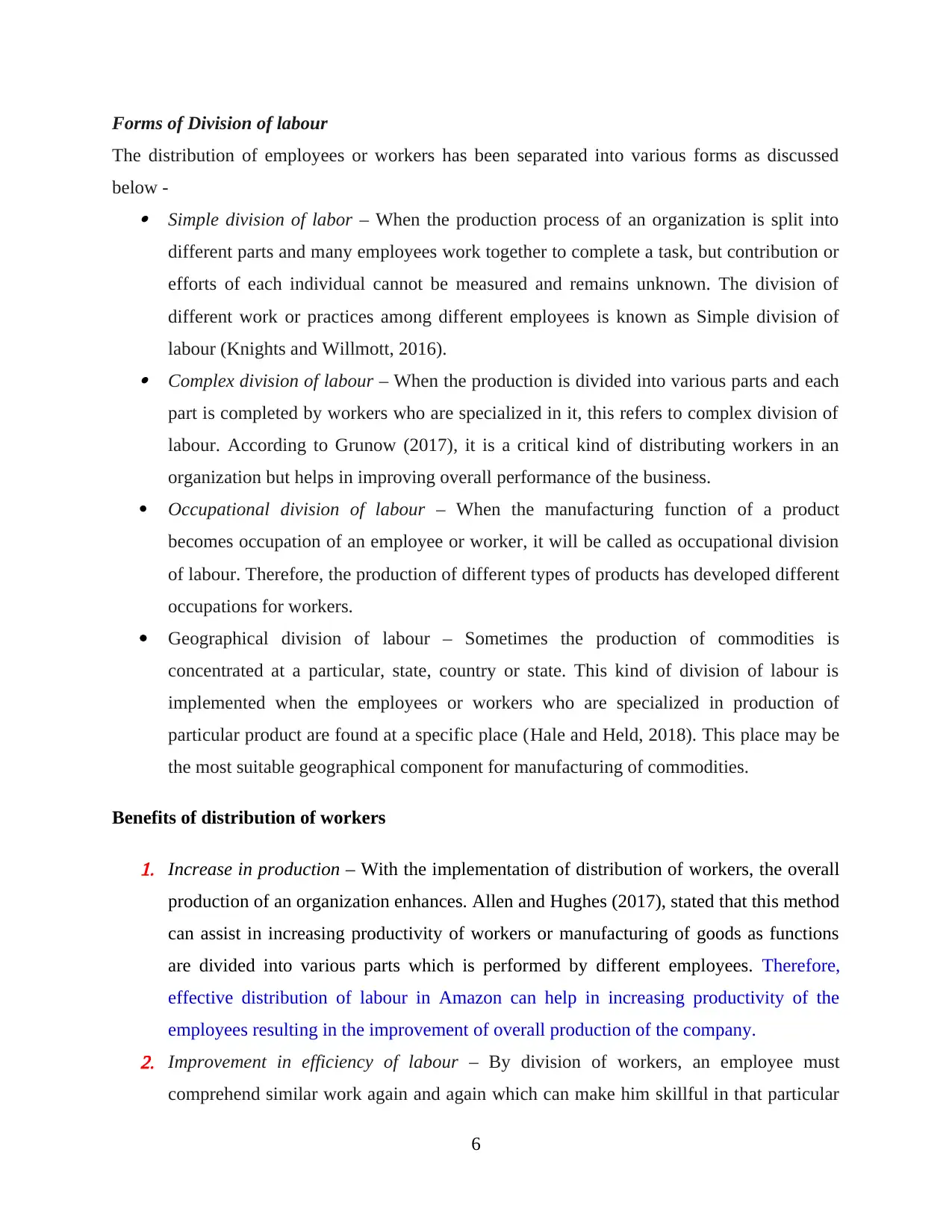
Forms of Division of labour
The distribution of employees or workers has been separated into various forms as discussed
below - Simple division of labor – When the production process of an organization is split into
different parts and many employees work together to complete a task, but contribution or
efforts of each individual cannot be measured and remains unknown. The division of
different work or practices among different employees is known as Simple division of
labour (Knights and Willmott, 2016). Complex division of labour – When the production is divided into various parts and each
part is completed by workers who are specialized in it, this refers to complex division of
labour. According to Grunow (2017), it is a critical kind of distributing workers in an
organization but helps in improving overall performance of the business.
Occupational division of labour – When the manufacturing function of a product
becomes occupation of an employee or worker, it will be called as occupational division
of labour. Therefore, the production of different types of products has developed different
occupations for workers.
Geographical division of labour – Sometimes the production of commodities is
concentrated at a particular, state, country or state. This kind of division of labour is
implemented when the employees or workers who are specialized in production of
particular product are found at a specific place (Hale and Held, 2018). This place may be
the most suitable geographical component for manufacturing of commodities.
Benefits of distribution of workers
1. Increase in production – With the implementation of distribution of workers, the overall
production of an organization enhances. Allen and Hughes (2017), stated that this method
can assist in increasing productivity of workers or manufacturing of goods as functions
are divided into various parts which is performed by different employees. Therefore,
effective distribution of labour in Amazon can help in increasing productivity of the
employees resulting in the improvement of overall production of the company.2. Improvement in efficiency of labour – By division of workers, an employee must
comprehend similar work again and again which can make him skillful in that particular
6
The distribution of employees or workers has been separated into various forms as discussed
below - Simple division of labor – When the production process of an organization is split into
different parts and many employees work together to complete a task, but contribution or
efforts of each individual cannot be measured and remains unknown. The division of
different work or practices among different employees is known as Simple division of
labour (Knights and Willmott, 2016). Complex division of labour – When the production is divided into various parts and each
part is completed by workers who are specialized in it, this refers to complex division of
labour. According to Grunow (2017), it is a critical kind of distributing workers in an
organization but helps in improving overall performance of the business.
Occupational division of labour – When the manufacturing function of a product
becomes occupation of an employee or worker, it will be called as occupational division
of labour. Therefore, the production of different types of products has developed different
occupations for workers.
Geographical division of labour – Sometimes the production of commodities is
concentrated at a particular, state, country or state. This kind of division of labour is
implemented when the employees or workers who are specialized in production of
particular product are found at a specific place (Hale and Held, 2018). This place may be
the most suitable geographical component for manufacturing of commodities.
Benefits of distribution of workers
1. Increase in production – With the implementation of distribution of workers, the overall
production of an organization enhances. Allen and Hughes (2017), stated that this method
can assist in increasing productivity of workers or manufacturing of goods as functions
are divided into various parts which is performed by different employees. Therefore,
effective distribution of labour in Amazon can help in increasing productivity of the
employees resulting in the improvement of overall production of the company.2. Improvement in efficiency of labour – By division of workers, an employee must
comprehend similar work again and again which can make him skillful in that particular
6
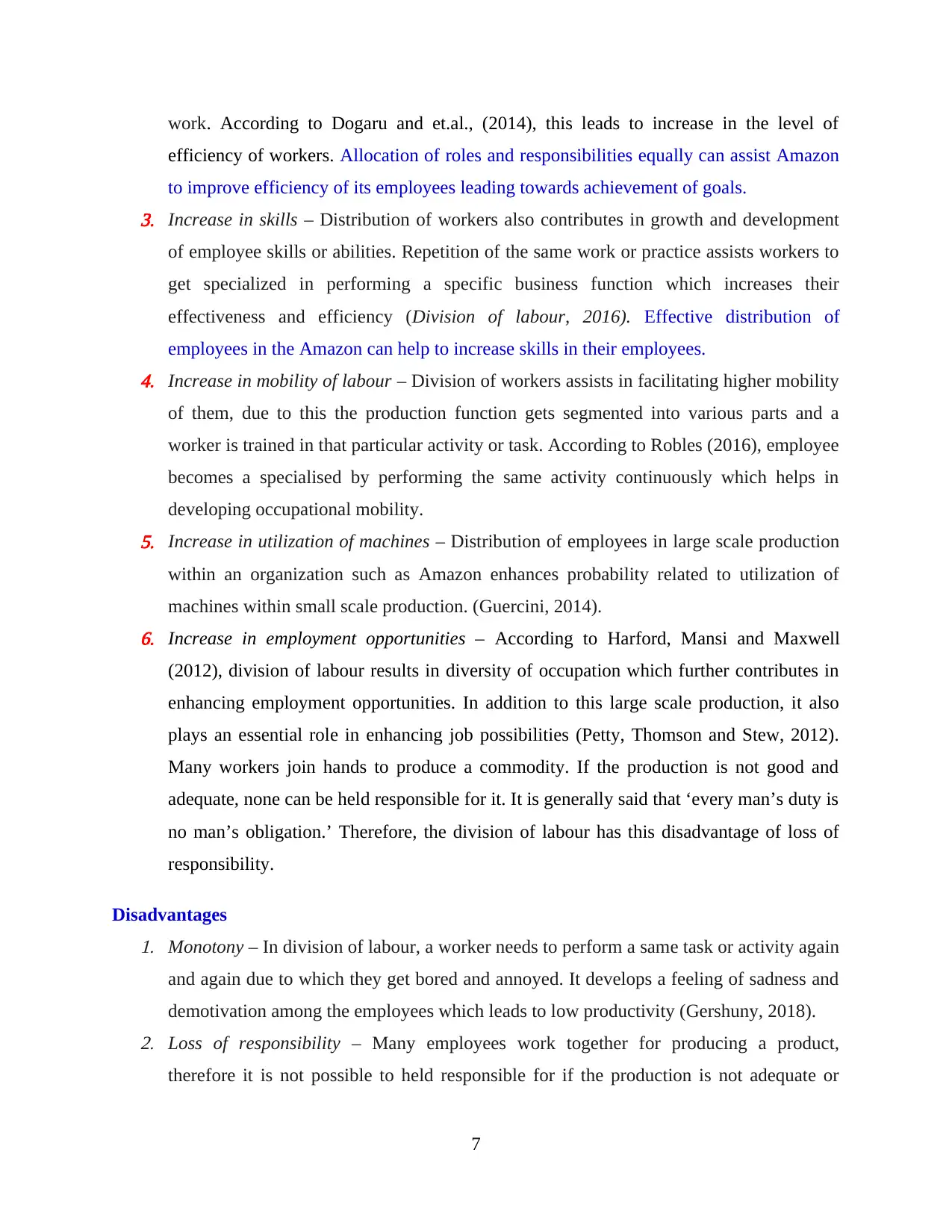
work. According to Dogaru and et.al., (2014), this leads to increase in the level of
efficiency of workers. Allocation of roles and responsibilities equally can assist Amazon
to improve efficiency of its employees leading towards achievement of goals.3. Increase in skills – Distribution of workers also contributes in growth and development
of employee skills or abilities. Repetition of the same work or practice assists workers to
get specialized in performing a specific business function which increases their
effectiveness and efficiency (Division of labour, 2016). Effective distribution of
employees in the Amazon can help to increase skills in their employees.4. Increase in mobility of labour – Division of workers assists in facilitating higher mobility
of them, due to this the production function gets segmented into various parts and a
worker is trained in that particular activity or task. According to Robles (2016), employee
becomes a specialised by performing the same activity continuously which helps in
developing occupational mobility.5. Increase in utilization of machines – Distribution of employees in large scale production
within an organization such as Amazon enhances probability related to utilization of
machines within small scale production. (Guercini, 2014).6. Increase in employment opportunities – According to Harford, Mansi and Maxwell
(2012), division of labour results in diversity of occupation which further contributes in
enhancing employment opportunities. In addition to this large scale production, it also
plays an essential role in enhancing job possibilities (Petty, Thomson and Stew, 2012).
Many workers join hands to produce a commodity. If the production is not good and
adequate, none can be held responsible for it. It is generally said that ‘every man’s duty is
no man’s obligation.’ Therefore, the division of labour has this disadvantage of loss of
responsibility.
Disadvantages1. Monotony – In division of labour, a worker needs to perform a same task or activity again
and again due to which they get bored and annoyed. It develops a feeling of sadness and
demotivation among the employees which leads to low productivity (Gershuny, 2018).2. Loss of responsibility – Many employees work together for producing a product,
therefore it is not possible to held responsible for if the production is not adequate or
7
efficiency of workers. Allocation of roles and responsibilities equally can assist Amazon
to improve efficiency of its employees leading towards achievement of goals.3. Increase in skills – Distribution of workers also contributes in growth and development
of employee skills or abilities. Repetition of the same work or practice assists workers to
get specialized in performing a specific business function which increases their
effectiveness and efficiency (Division of labour, 2016). Effective distribution of
employees in the Amazon can help to increase skills in their employees.4. Increase in mobility of labour – Division of workers assists in facilitating higher mobility
of them, due to this the production function gets segmented into various parts and a
worker is trained in that particular activity or task. According to Robles (2016), employee
becomes a specialised by performing the same activity continuously which helps in
developing occupational mobility.5. Increase in utilization of machines – Distribution of employees in large scale production
within an organization such as Amazon enhances probability related to utilization of
machines within small scale production. (Guercini, 2014).6. Increase in employment opportunities – According to Harford, Mansi and Maxwell
(2012), division of labour results in diversity of occupation which further contributes in
enhancing employment opportunities. In addition to this large scale production, it also
plays an essential role in enhancing job possibilities (Petty, Thomson and Stew, 2012).
Many workers join hands to produce a commodity. If the production is not good and
adequate, none can be held responsible for it. It is generally said that ‘every man’s duty is
no man’s obligation.’ Therefore, the division of labour has this disadvantage of loss of
responsibility.
Disadvantages1. Monotony – In division of labour, a worker needs to perform a same task or activity again
and again due to which they get bored and annoyed. It develops a feeling of sadness and
demotivation among the employees which leads to low productivity (Gershuny, 2018).2. Loss of responsibility – Many employees work together for producing a product,
therefore it is not possible to held responsible for if the production is not adequate or
7
⊘ This is a preview!⊘
Do you want full access?
Subscribe today to unlock all pages.

Trusted by 1+ million students worldwide
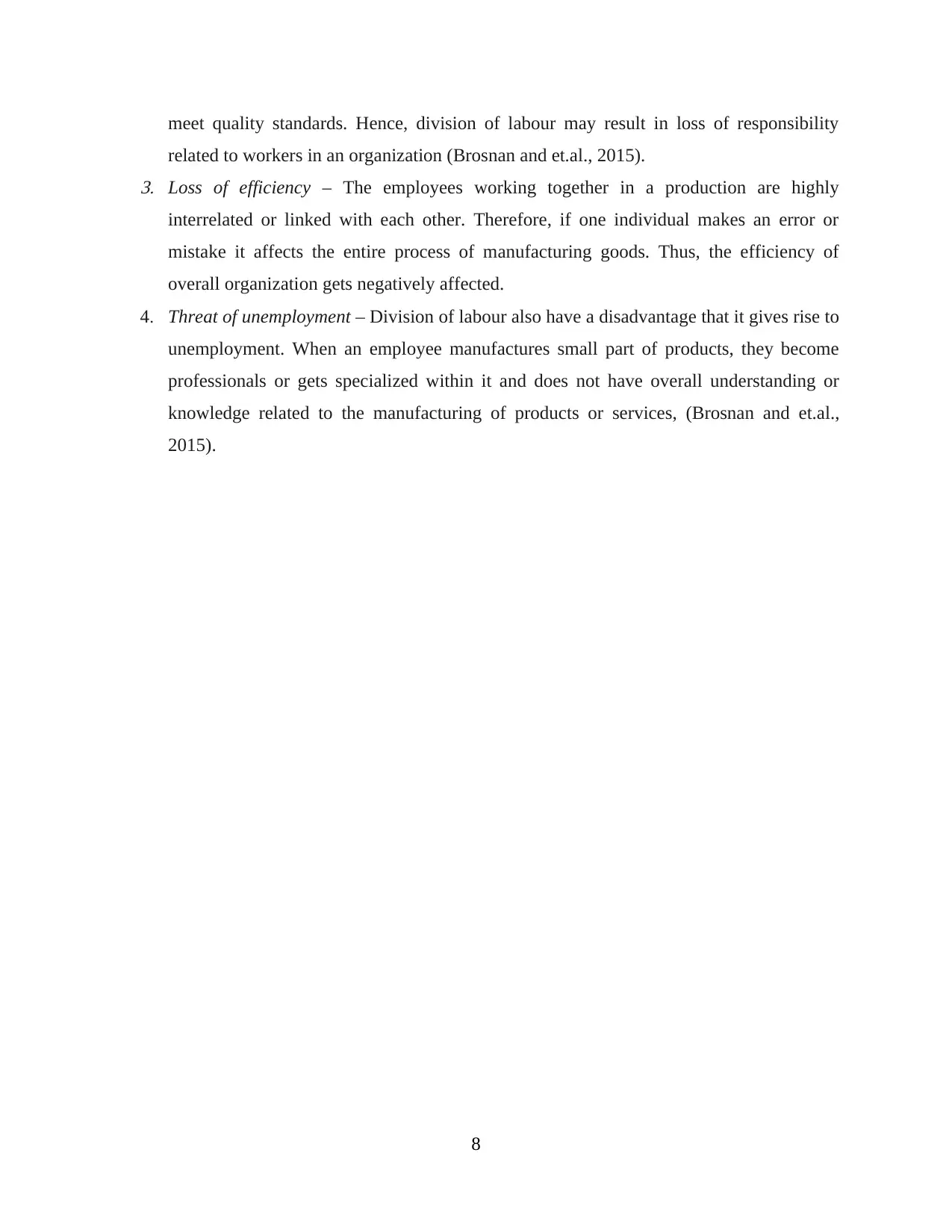
meet quality standards. Hence, division of labour may result in loss of responsibility
related to workers in an organization (Brosnan and et.al., 2015).3. Loss of efficiency – The employees working together in a production are highly
interrelated or linked with each other. Therefore, if one individual makes an error or
mistake it affects the entire process of manufacturing goods. Thus, the efficiency of
overall organization gets negatively affected.
4. Threat of unemployment – Division of labour also have a disadvantage that it gives rise to
unemployment. When an employee manufactures small part of products, they become
professionals or gets specialized within it and does not have overall understanding or
knowledge related to the manufacturing of products or services, (Brosnan and et.al.,
2015).
8
related to workers in an organization (Brosnan and et.al., 2015).3. Loss of efficiency – The employees working together in a production are highly
interrelated or linked with each other. Therefore, if one individual makes an error or
mistake it affects the entire process of manufacturing goods. Thus, the efficiency of
overall organization gets negatively affected.
4. Threat of unemployment – Division of labour also have a disadvantage that it gives rise to
unemployment. When an employee manufactures small part of products, they become
professionals or gets specialized within it and does not have overall understanding or
knowledge related to the manufacturing of products or services, (Brosnan and et.al.,
2015).
8
Paraphrase This Document
Need a fresh take? Get an instant paraphrase of this document with our AI Paraphraser
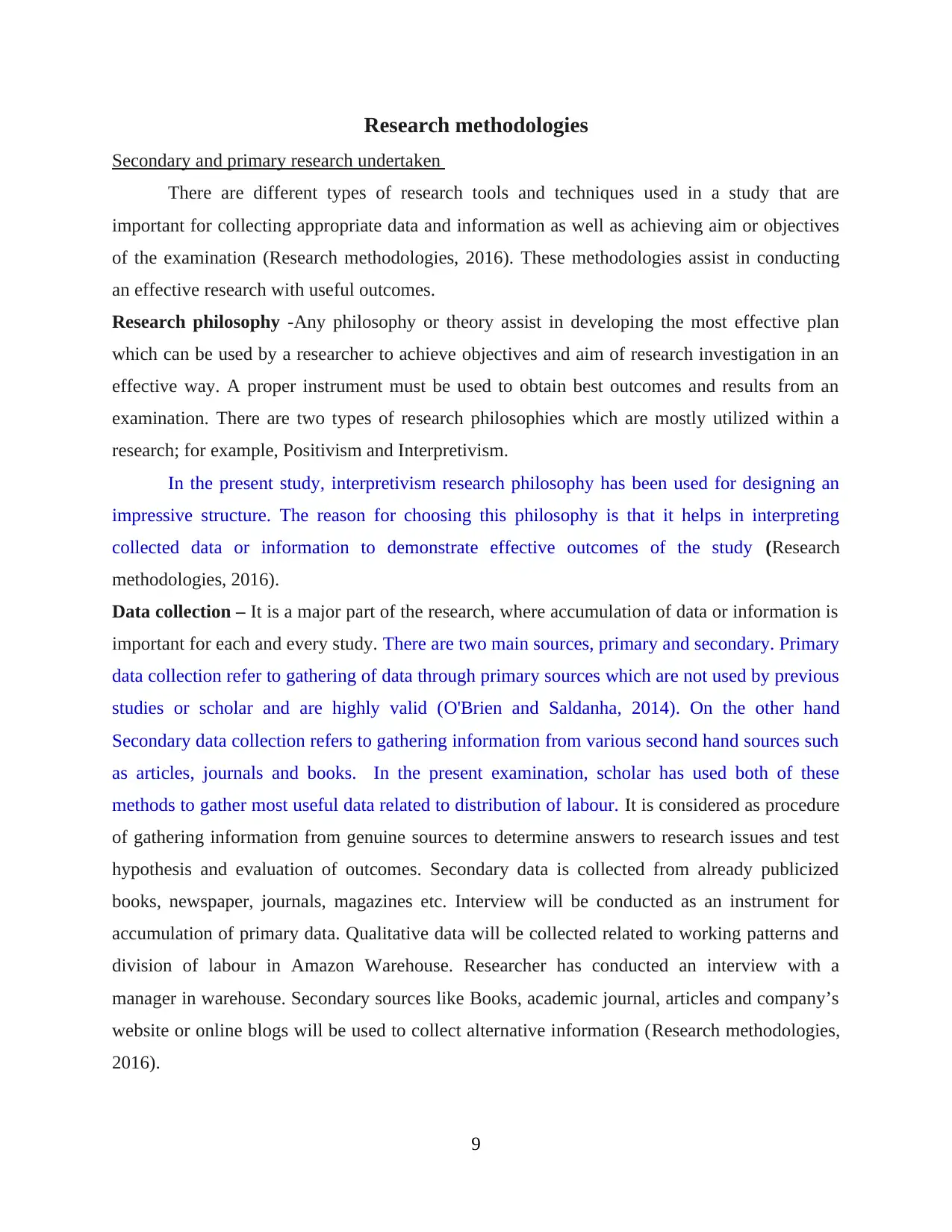
Research methodologies
Secondary and primary research undertaken
There are different types of research tools and techniques used in a study that are
important for collecting appropriate data and information as well as achieving aim or objectives
of the examination (Research methodologies, 2016). These methodologies assist in conducting
an effective research with useful outcomes.
Research philosophy -Any philosophy or theory assist in developing the most effective plan
which can be used by a researcher to achieve objectives and aim of research investigation in an
effective way. A proper instrument must be used to obtain best outcomes and results from an
examination. There are two types of research philosophies which are mostly utilized within a
research; for example, Positivism and Interpretivism.
In the present study, interpretivism research philosophy has been used for designing an
impressive structure. The reason for choosing this philosophy is that it helps in interpreting
collected data or information to demonstrate effective outcomes of the study (Research
methodologies, 2016).
Data collection – It is a major part of the research, where accumulation of data or information is
important for each and every study. There are two main sources, primary and secondary. Primary
data collection refer to gathering of data through primary sources which are not used by previous
studies or scholar and are highly valid (O'Brien and Saldanha, 2014). On the other hand
Secondary data collection refers to gathering information from various second hand sources such
as articles, journals and books. In the present examination, scholar has used both of these
methods to gather most useful data related to distribution of labour. It is considered as procedure
of gathering information from genuine sources to determine answers to research issues and test
hypothesis and evaluation of outcomes. Secondary data is collected from already publicized
books, newspaper, journals, magazines etc. Interview will be conducted as an instrument for
accumulation of primary data. Qualitative data will be collected related to working patterns and
division of labour in Amazon Warehouse. Researcher has conducted an interview with a
manager in warehouse. Secondary sources like Books, academic journal, articles and company’s
website or online blogs will be used to collect alternative information (Research methodologies,
2016).
9
Secondary and primary research undertaken
There are different types of research tools and techniques used in a study that are
important for collecting appropriate data and information as well as achieving aim or objectives
of the examination (Research methodologies, 2016). These methodologies assist in conducting
an effective research with useful outcomes.
Research philosophy -Any philosophy or theory assist in developing the most effective plan
which can be used by a researcher to achieve objectives and aim of research investigation in an
effective way. A proper instrument must be used to obtain best outcomes and results from an
examination. There are two types of research philosophies which are mostly utilized within a
research; for example, Positivism and Interpretivism.
In the present study, interpretivism research philosophy has been used for designing an
impressive structure. The reason for choosing this philosophy is that it helps in interpreting
collected data or information to demonstrate effective outcomes of the study (Research
methodologies, 2016).
Data collection – It is a major part of the research, where accumulation of data or information is
important for each and every study. There are two main sources, primary and secondary. Primary
data collection refer to gathering of data through primary sources which are not used by previous
studies or scholar and are highly valid (O'Brien and Saldanha, 2014). On the other hand
Secondary data collection refers to gathering information from various second hand sources such
as articles, journals and books. In the present examination, scholar has used both of these
methods to gather most useful data related to distribution of labour. It is considered as procedure
of gathering information from genuine sources to determine answers to research issues and test
hypothesis and evaluation of outcomes. Secondary data is collected from already publicized
books, newspaper, journals, magazines etc. Interview will be conducted as an instrument for
accumulation of primary data. Qualitative data will be collected related to working patterns and
division of labour in Amazon Warehouse. Researcher has conducted an interview with a
manager in warehouse. Secondary sources like Books, academic journal, articles and company’s
website or online blogs will be used to collect alternative information (Research methodologies,
2016).
9

Sampling – It refers to choice of a target group through which data has to be gathered. This is
also a useful technique for collecting the most suitable data from various individuals. Sampling
techniques have been segmented in two classes such as probabilistic and non-probabilistic
theories. As study is qualitative in nature, Simple Random Sampling Method will be utilized by
researcher for selecting sample method. Philosophy behind selection of this theory is that it
eliminates biases from selection processes (Research methodologies, 2016). Through this simple
random sampling technique, 1 manager of Amazon F.C has been chosen as sample size amongst
the big population of employees in Amazon Warehouse.
Ethical considerations - There are various ethical considerations which are necessary to be
followed while conducting any research. There are different codes and ethics needed to be
considered such as honesty, society, confidentiality, responsibility, and non-discrimination.
Researcher must make sure that each and every ethical code is taken into consideration while
conducting the research. The managers have been informed about procedure of examination,
approval was taken before conducting the interview. This helped in obtaining the best results and
outcomes from research study (Brosnan and et.al., 2015).
Validity – It can refer as reality of examination or study conducted by a scholar and this depends
upon various factors such as publishing date of various books or articles through which data is
collected. There are different issues which can affect an examination such as morality,
maturation, testing and ambiguity that can harm entire research, therefore it is important to
consider all these elements in data collection and analysis of the same.
Source of error – There is a great probability of errors in accumulation of data and its analysis
which can be eliminated if determined at the right time. There are various ways in which faults
can occur; for example, interpretation, processing, etc. While collecting research data, there are
probabilities for measuring problems or issues. Proper revisions of interview or other research
activities can help in avoiding any type of obstacles in the examination (Research methodologies,
2016).
10
also a useful technique for collecting the most suitable data from various individuals. Sampling
techniques have been segmented in two classes such as probabilistic and non-probabilistic
theories. As study is qualitative in nature, Simple Random Sampling Method will be utilized by
researcher for selecting sample method. Philosophy behind selection of this theory is that it
eliminates biases from selection processes (Research methodologies, 2016). Through this simple
random sampling technique, 1 manager of Amazon F.C has been chosen as sample size amongst
the big population of employees in Amazon Warehouse.
Ethical considerations - There are various ethical considerations which are necessary to be
followed while conducting any research. There are different codes and ethics needed to be
considered such as honesty, society, confidentiality, responsibility, and non-discrimination.
Researcher must make sure that each and every ethical code is taken into consideration while
conducting the research. The managers have been informed about procedure of examination,
approval was taken before conducting the interview. This helped in obtaining the best results and
outcomes from research study (Brosnan and et.al., 2015).
Validity – It can refer as reality of examination or study conducted by a scholar and this depends
upon various factors such as publishing date of various books or articles through which data is
collected. There are different issues which can affect an examination such as morality,
maturation, testing and ambiguity that can harm entire research, therefore it is important to
consider all these elements in data collection and analysis of the same.
Source of error – There is a great probability of errors in accumulation of data and its analysis
which can be eliminated if determined at the right time. There are various ways in which faults
can occur; for example, interpretation, processing, etc. While collecting research data, there are
probabilities for measuring problems or issues. Proper revisions of interview or other research
activities can help in avoiding any type of obstacles in the examination (Research methodologies,
2016).
10
⊘ This is a preview!⊘
Do you want full access?
Subscribe today to unlock all pages.

Trusted by 1+ million students worldwide
1 out of 38
Related Documents
Your All-in-One AI-Powered Toolkit for Academic Success.
+13062052269
info@desklib.com
Available 24*7 on WhatsApp / Email
![[object Object]](/_next/static/media/star-bottom.7253800d.svg)
Unlock your academic potential
Copyright © 2020–2025 A2Z Services. All Rights Reserved. Developed and managed by ZUCOL.





